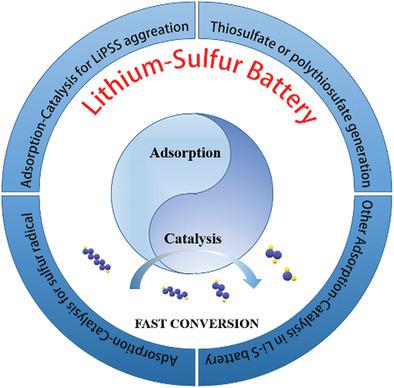当前位置:
X-MOL 学术
›
Adv. Energy Mater.
›
论文详情
Our official English website, www.x-mol.net, welcomes your
feedback! (Note: you will need to create a separate account there.)
Adsorption‐Catalysis Design in the Lithium‐Sulfur Battery
Advanced Energy Materials ( IF 24.4 ) Pub Date : 2019-11-19 , DOI: 10.1002/aenm.201903008 Miao Zhang 1 , Wei Chen 1 , Lanxin Xue 1, 2 , Yu Jiao 3 , Tianyu Lei 1 , Junwei Chu 1 , Jianwen Huang 1 , Chuanhui Gong 1 , Chaoyi Yan 1 , Yichao Yan 1 , Yin Hu 1 , Xianfu Wang 1 , Jie Xiong 1
Advanced Energy Materials ( IF 24.4 ) Pub Date : 2019-11-19 , DOI: 10.1002/aenm.201903008 Miao Zhang 1 , Wei Chen 1 , Lanxin Xue 1, 2 , Yu Jiao 3 , Tianyu Lei 1 , Junwei Chu 1 , Jianwen Huang 1 , Chuanhui Gong 1 , Chaoyi Yan 1 , Yichao Yan 1 , Yin Hu 1 , Xianfu Wang 1 , Jie Xiong 1
Affiliation

|
Lithium‐sulfur (Li‐S) batteries are one of the most promising next‐generation energy‐storage systems. Nevertheless, the sluggish sulfur redox and shuttle effect in Li‐S batteries are the major obstacles to their commercial application. Previous investigations on adsorption for LiPSs have made great progress but cannot restrain the shuttle effect. Catalysts can enhance the reaction kinetics, and then alleviate the shuttle effect. The synergistic relationship between adsorption and catalysis has become the hotspot for research into suppressing the shuttle effect and improving battery performance. Herein, the adsorption‐catalysis synergy in Li‐S batteries is reviewed, the adsorption‐catalysis designs are divided into four categories: adsorption‐catalysis for LiPSs aggregation, polythionate or thiosulfate generation, and sulfur radical formation, as well as other adsorption‐catalysis. Then advanced strategies, future perspectives, and challenges are proposed to aim at long‐life and high‐efficiency Li‐S batteries.
中文翻译:

锂硫电池的吸附催化设计
锂硫(Li‐S)电池是最有前途的下一代储能系统之一。然而,锂硫电池的硫氧化还原反应缓慢和穿梭效应是其商业应用的主要障碍。以前对LiPS吸附的研究取得了很大进展,但不能抑制穿梭效应。催化剂可以增强反应动力学,进而减轻穿梭效应。吸附与催化之间的协同关系已成为研究抑制穿梭效应和改善电池性能的热点。在此,对Li-S电池中的吸附-催化协同作用进行了综述,并将吸附-催化设计分为四类:LiPSs聚集的吸附-催化,聚硫酸盐或硫代硫酸盐的产生以及硫自由基的形成,以及其他吸附催化。然后,针对长寿命和高效率的Li-S电池,提出了先进的策略,未来的观点和挑战。
更新日期:2020-01-14
中文翻译:

锂硫电池的吸附催化设计
锂硫(Li‐S)电池是最有前途的下一代储能系统之一。然而,锂硫电池的硫氧化还原反应缓慢和穿梭效应是其商业应用的主要障碍。以前对LiPS吸附的研究取得了很大进展,但不能抑制穿梭效应。催化剂可以增强反应动力学,进而减轻穿梭效应。吸附与催化之间的协同关系已成为研究抑制穿梭效应和改善电池性能的热点。在此,对Li-S电池中的吸附-催化协同作用进行了综述,并将吸附-催化设计分为四类:LiPSs聚集的吸附-催化,聚硫酸盐或硫代硫酸盐的产生以及硫自由基的形成,以及其他吸附催化。然后,针对长寿命和高效率的Li-S电池,提出了先进的策略,未来的观点和挑战。


















































 京公网安备 11010802027423号
京公网安备 11010802027423号